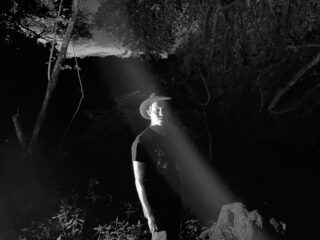We had a bit of a moment watching Simon Joyner at End Of The Road
Everyone here has a Simon Joyner story

Everyone here has a Simon Joyner story
With the first rule of music journalism being not to write yourself into the story, I’ll get my apologies in early. The right amount of End Of The Road Ale has settled in the right way, it’s the right temperature with the right breeze soughing the leaves into the woodland floor; the right haybale with the right cushioning lulls an attentive audience to the Talking Heads stage, sat still and listening.
Simon Joyner’s The Lousy Dance was one of the first records I bought, after a friend of mine called Joe assured me that he was a musician’s musician. I’m not a musician but was eager to show willing. At the time, The Lousy Dance was the cheapest of his albums I could find – it’s possibly worth even less now. I haven’t spoken to Joe in nearly a decade, but my copy of The Lousy Dance has scuffed corners.
The trees hugging the concave wooden stage have their branches shining in purples, lit brighter once the early evening comes down a little further. Joyner sits in the middle, crouched over his acoustic guitar, a cellist and second guitarist flanking his either side. Booking him to play at the End Of The Road is a wilful excavation of many artists who have made this festival what it is – he’s a major footnote on the young journal pages of headliners now and then – free from the non-descript nihilism of the household troubadours but with the same weary wisdom.
Although taken from his latest record barely turning one year old, a line about something as everyday as a jar of chickpeas in ‘Caroline’s Got A Secret’ has me and everyone else holding back tears. Joyner’s the kind of artist with whom everyone here appears to have their own story, even if it’s just beginning now. It makes for a willing surrounding to feel things, which is the thing with time and place. The crowd has separated off into hundreds of little times and places. “You’ll find my azaleas love the shadows,” he sings. “They’ll bring out hummingbirds and butterflies.”
A kid is yelling in the forest to the right of us. A few elderly fans look across with a smile across their face. These songs champion background noise – they bring that noise inside. On ‘Blue Lullaby’ he sings of cicadas sounding like radiators. On an older song – ‘The Black Dog’ – a cello scratch sounds like a yelp, and the electric guitar sounds like popping balloons. The kid in the forest is now climbing a tree for a better vantage point. Joyner’s rhymes fit like hand in glove; jumbles of words and intimate ramblings resolve themselves with the most natural curiosity, in the same way his tone swans around the right note – deviating from it and missing it – momentarily locking into it, mostly by accident.
A woman in front of me is painting the performance in watercolour, where the purple shapes bleed over Joyner’s face making skin indistinguishable from branch. “I could’ve called this song the painter or the singer or the dancer,” he muses, “but I was too scared.” He sings about being carved and craved by Hollywood in equal measure. It’s a song about winding up a career, but the song goes on and on and on, unwilling to end.
Noise starts coming through the trees from another stage, as he introduces ‘The Rain Asked For A Holiday’ – “that’s her now,” he smiles. It’s a song from The Lousy Dance. A bug is crawling down my neck. The kid in the woods is screaming again. The guitars in the distance have mellowed. I don’t think any of our photographers caught the gig. I’ll ask if I can take a picture of him on my phone in front of the trees. He’s signed that woman’s painting. The picture I took is saturated in heavy purple. I’ll make it black and white.